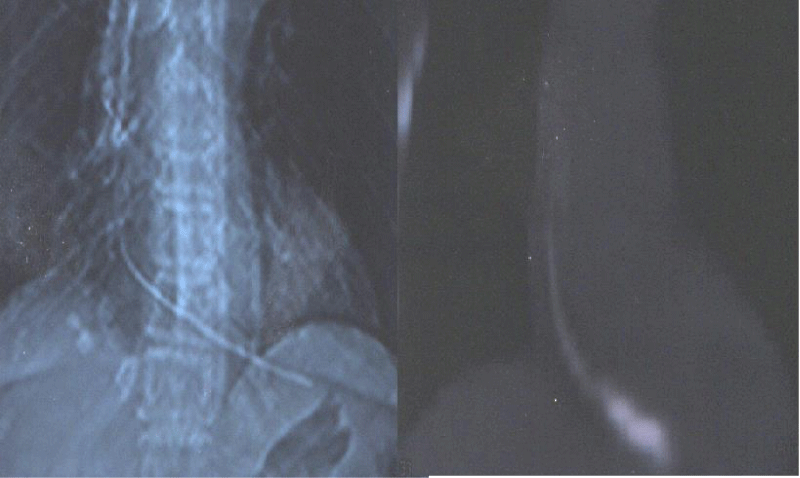Archives of Hematology Case Reports and Reviews
Are We Performing the Right Long Term Thromboprophylaxis of Port-A-Cath? Report of a Case of Upper Limb DVT with PE and Port-A-Cath Migration
Pierpaolo Di Micco1*, Luca Fontanella1, Andrea Fontanella1 and Luigi Pirolo2
2Servizio di Radiologia, Ospedale Fatebenefratelli di Napoli, Napoli, Italy
Cite this as
Di Micco P, Fontanella L, Fontanella A, Pirolo L (2017) Are We Performing the Right Long Term Thromboprophylaxis of Port-A-Cath? Report of a Case of Upper Limb DVT with PE and Port-A-Cath Migration. Arch Hematol Case Rep Rev 2(1): 010-012. DOI: 10.17352/ahcrr.000007Upper limb DVT occurs in nearly 4-10%, but incidence increases in people that carry catheters for a long time. However thromboprophylaxis in carriers of catheters is not suggested. We report a case of upper limb DVT with pulmonary embolism with catheter migration into the heart.
Background
Upper limb deep vein thrombosis (DVT) is less frequent than lower limb DVT. However, in the last decades an increased frequency of upper limb DVT has been detected due to a better diagnostic approach and to an increase of central venous lines (CVL) to perform chemotherapy or other intravenous treatment. Central venous lines may be placed as central venous catheters (CVC) or port-a-cath or peripherally inserted central catheters (PICC). The daily cleaning of these supports is usually suggested in order to escape common complications as infection or thrombosis [1,2], thrombosis of CVL may appear as thrombosis of full vein or local partial thrombosis with catheter dysfunction (i.e. sleeve thrombosis) [3].
Thrombotic risk factors for upper limb DVT other than presence of CVL are similar to those of lower limb DVT (i.e. thrombophilia, cancer, hypomobility, recent surgery, oestrogen hormonal administration) [3], yet also local infection or systemic infection of CVL may increase the risk of a catheter related DVT of upper limb [1,3]. Actually upper limb DVT is diagnosed in approximately 4-10% of all cases of DVT and cases of catheter-related DVT are 1.7 per 1000 patients [4]. Moreover, the presence of catheter seems to be associated also to an increased rate of pulmonary embolism (PE) [2,5]. However, for patients that carry a central catheter, a port-a-cath, a central venous line, a pacemaker for a long time, few guidelines are available to prevent a complication as DVT. This approach is due to a limited benefit showed by several trials that compared antithrombotic treatment to a non-antithrombotic treatment in oncological patients with CVL [6].
We here report a singular case of prolonged permanence of port-a-cath also after the end of chemotherapy of an old patient complicated by DVT, PE and the migration of a port-a-cath into right heart.
Case Description
An 86 years old woman was admitted to emergency room for oedema and painful upper right arm and hand; the reported symptoms started in the last 48 hours without recent trauma or recent surgical procedures. Her anamnesis showed osteoporosis and hypertension with treatment with enalapril 20 mg daily and weekly vitamin D3 administration; past pathological anamnesis revealed breast cancer nearly 15 years ago treated with surgery and following adjuvant intravenous chemotherapy; in particular she was affected by ductal breast carcinoma treated by quadrantectomy and adjuvant chemotherapy based on doxorubicin, cyclophosphamide and paclitaxel.
Normal values of blood pressure (i.e. 130\60 mmhg) and pulsoxymetry were present (i.e, 97%), while a light tachycardia and fever were found (115 bpm and TC 37.2 °C, respectively). Blood samples, ECG and chest X-ray examination were planned. ECG confirmed sinus tachycardia with 120 bpm without abnormalities, while X-ray did not reveal any pathological findings. Physical examinations revealed collateral veins in subclavian area and to the right arm and blood samples showed leucocytosis (i.e. 14.100 mm cube) and increased d-dimer (2916 mcg\dL).
So, an ultrasound vascular scan with color Doppler was planned for the right limb and it revealed a full thrombosis of deep venous axis (i.e. subclavian and axillar veins) and also of the port-a-cath that was placed several years before in order to perform chemotherapy for her breast cancer but it was forgotten to be removed after cancer remission and follow up and that patients did not revealed at the anamnesis.
Immediately a treatment based on full therapeutic doses of low molecular weight heparin (i.e. clexane 6000 U twice daily) was started and associated to antibiotics with large spectrum (i.e. ceftriaxone 2g daily) to prevent further infections; acetoaminofene (1 g twice daily) was associated too for the treatment of pain.
After 24-36 hours the referred arm pain improved but one day after a sudden strong chest pain with dyspnea and clinical signs of heart failure, appeared. Blood pressure decreased (i.e. 95/60 mmHg) and altered mental status appeared. A bed-side chest X-ray and a following pulmonal CT scan were planned and revealed an enlargement of the heart area, associated to multiple emboli and also to the migration of the port-a-cath into the right sections of the heart (Figure 1).
Because of life threatening haemodynamic failure, the surgical approach to remove the catheter was not the first choice of treatment, another pharmacological approach with intravenous unfractioned heparin was started (i.e. 5000 U bolus followed by 30000 U daily according to aPTT monitor) in order to wait an improvement of blood pressure and haemodynamic status but the improvement did not appear and after 10 hours the patient died.
Discussion
Symptomatic thromboembolic complications of central venous catheters occur in nearly 1.7/1000 of oncological patients while asymptomatic thrombi seem to be more frequent [4]. The incidence is increased in thrombophilic subjects as reported by the MAISTHRO registry [7], also for this reason clinical complications as recurrent PE has been reported in patients with catheter related DVT [2,5].
Based on previously reported data thromboprophylaxis actually is not suggested by guidelines and this concept has been also underlined by results of different randomized trials that compared patients with CVL, with and without different thromboprophylaxis regimens (i.e. low doses of low molecular weight heparin or low fixed doses of warfarin), to placebo [6]. Few studies in fact identified clinical risk factors that predispose oncological patients to develop thrombosis due to CVL and suggested prophylaxis during chemotherapy [8]; on other hand there are not studies that take into account to monitor thrombotic complications in carriers of CVL without removal after the end chemotherapy or other infusional treatments.
However catheter removal is suggested after the end of chemotherapy and in particular if there are not increased risks to remove it otherwise CVL care recognizes several performances that should be daily and routinely performed in order to avoid life threatening complication (i.e. recent infection or recent thrombosis) [9]. This point makes a difference for our reported patient that ended her chemotherapy several years before the arm DVT and did not remove her port-a-cath. Moreover, no prophylaxis for infection or thrombosis of CVL was performed for several years. So, the reported thrombotic complications may be also due to this relevant aspect together to the bad outcome.
In our daily clinical management we observed that the forgotten removal of CVL or port-a-cath or PICC is relatively frequent and this could represent a particular point to be discussed for next clinical trials and registries. The long term prophylaxis, for patients that do not remove CVL or port-a-cath, for any reason, is really different because asymptomatic thrombi, local infections with sleeve thrombosis of CVL, malposition and subsequent thrmboembolic complication, migration of CVL , are all conditions that should be better monitored. In particular, in our case, catheter migration could also due to several years of progressive local microthrombi and following malposition with final migration to the right hearth section and following cardiogenic shock.
New strategies should be focused on registries or randomized trials in order to avoid to forget CVL or port-a-cath and their routinely prophylaxis.
- Del Principe MI, Buccisano F, Maurillo L, Venditti D, Cefalo M, et al. (2013) Infections increase the risk of central venous catheter-related thrombosis in adult acute myeloid leukemia. Thromb Res 132: 511-514. Link: https://goo.gl/IEgvMI
- Cote LP, Greenberg S, Caprini JA, Tafur A, Choi C, et al. (2016) Comparison between upper and lower extremity deep vein thrombosis: a review of the RIETE registry. Clin Appl Thromb Haemost. Link: https://goo.gl/IS2auy
- Di Micco P, Di Fiore R, Quaranta S, Viggiano GV, Romano IJ, et al. (2007) Upper limb deep vein thrombosis: update of risk factors in oncological patients. Cancer therapy 5: 391-394. Link: https://goo.gl/nrxA0V
- Jasti N, Streiff MB (2014) Prevention and treatment of thrombosis associated with central venous catheters in cancer patients. Expert Rev Hematol 7: 599-616. Link: https://goo.gl/2h6qnD
- Munoz FJ, Mismetti P, Poggio R, Valle R, Barron M, et al. (2008) Clinical outcome of patients with upper-extremity deep vein thrombosis. Chest 133: 143-148. Link: https://goo.gl/XYf2jU
- Linenberger ML (2006) Catheter-related thrombosis: risk, diagnosis, and management. J Natl Compr Canc Netw 9: 889-901. Link: https://goo.gl/jm6X3Q
- Linnemann B, Meister F, Schwonberg J, Schinewolf M, Zgouras D, et al. (2008) Hereditary and acquired thrombophilia in patients with upper extremity deep-vein thrombosis. Results from the MAISTHRO registry. Thromb Haemost 100: 440-446. Link: https://goo.gl/Mi4KEJ
- Moinat H, Periard D, Grueber A, Hayoz D, Magnin JL, et al. (2014) Predictors of venous thromboembolic events associated with central venous port insertion in cancer patients. J Oncol 2014: 743181. Link: https://goo.gl/lkdoKN
- Vescia S, Baumgartner K, Jacobs VR, Kiechle-Bahat M, Rody A, et al. (2008) Management of venous port system in oncology: a review of current evidence. Ann Oncol 19: 9-15. Link: https://goo.gl/5gVtjy
Article Alerts
Subscribe to our articles alerts and stay tuned.
 This work is licensed under a Creative Commons Attribution 4.0 International License.
This work is licensed under a Creative Commons Attribution 4.0 International License.


 Save to Mendeley
Save to Mendeley
